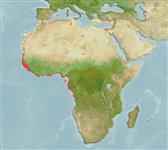>
Beloniformes (Needle fishes) >
Hemiramphidae (Halfbeaks)
Etymology: Hyporhamphus: Greek, hypo = under + Greek, rhamphos = beak, bill (Ref. 45335).
Eponymy: Monsieur Picart is said to have contributed natural history specimens from Cádiz, Spain, to the ‘King’s Cabinet’, but no further elaboration is made. (Ref. 128868), visit book page.
More on author: Valenciennes.
Environment: milieu / climate zone / depth range / distribution range
Ekologi
laut; payau bentopelagis; kisaran kedalaman 0 - ? m. Subtropical; 37°N - 9°S, 18°W - 36°E
Eastern Atlantic: West to Gibraltar, Morocco and Dakar, Senegal to Luanda, Angola. Eastern Mediterranean: From Lebanon and Israel.
Size / Weight / umur
Maturity: Lm ? range ? - ? cm
Max length : 20.0 cm TL jantan/; (Ref. 26999); common length : 15.0 cm TL jantan/; (Ref. 26999)
deskripsi pendek
Kunci identifiaksi (pengenalan) | Morfologi | Morfometrik
Duri punggung (Keseluruhan (total)) : 0; duri punggung lunak (Keseluruhan (total)) : 13 - 16; Duri dubur: 0; Sirip dubur lunak: 13 - 17. Diagnosis: body elongate; lower jaw forming long, narrow beak; upper jaw short, triangular and scaled; scales on snout; well developed preorbital crest between eye and nasal pit; pelvics fin abdominal; dorsal and anal fins placed far back on body and spineless; caudal fin slightly forked (Ref. 57227).
Occurs in coastal waters. Often enters estuaries (Ref. 2683). Live on or near the bottom where it feeds on algae and organic debris which it gathers from the surface of the sediment (Ref. 5377). Forms schools. Attracted to lights at night. Eggs are attached to aquatic vegetation by sticky threads (Ref. 6730).
Life cycle and mating behavior
Kematangan | Reproduksi, perkembang biakan | Pemijahan | telur-telur | Fecundity | Larva
Collette, B.B. and N.V. Parin, 1990. Hemiramphidae. p. 579-582. In J.C. Quero, J.C. Hureau, C. Karrer, A. Post and L. Saldanha (eds.) Check-list of the fishes of the eastern tropical Atlantic (CLOFETA). JNICT, Lisbon; SEI, Paris; and UNESCO, Paris. Vol. 2. (Ref. 4497)
Status IUCN Red List (Ref. 130435: Version 2024-1)
ancaman kepada manusia
Harmless
penggunaan manusia
Perikanan: komersial
Alat, peralatan
laporan khas
muat turun XML
Sumber internet
Estimates based on models
Preferred temperature (Ref.
123201): 18.4 - 27.9, mean 21.9 °C (based on 146 cells).
Phylogenetic diversity index (Ref.
82804): PD
50 = 0.5000 [Uniqueness, from 0.5 = low to 2.0 = high].
Bayesian length-weight: a=0.00257 (0.00115 - 0.00574), b=3.09 (2.91 - 3.27), in cm total length, based on LWR estimates for this Genus-body shape (Ref.
93245).
Trophic level (Ref.
69278): 2.0 ±0.00 se; based on food items.
Daya lenting (Ref.
120179): Tinggi, Waktu penggandaan populasi minimum kurang dari 15 bulan (Preliminary K or Fecundity.).
Fishing Vulnerability (Ref.
59153): Low vulnerability (10 of 100).
